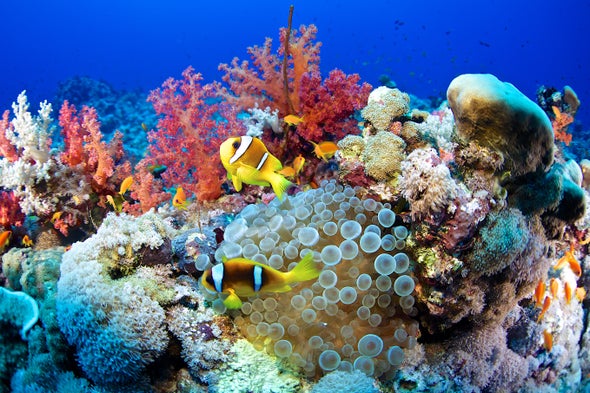(单词翻译:单击)
听力文本
This is Scientific American's 60-second Science, I'm Christopher Intagliata.
Colorful corals may be the stars of the reef—but they can't thrive without a huge supporting cast.
"Fish perform a load of really important roles on a coral reef."
Tim Gordon, a marine biologist at the University of Exeter. He says some fish graze on seaweed, clearing space for new corals. Others control whole food chains.
But when reefs are bleached or damaged, the fish flee, and the reef suffers. So how do you get them back? One trick may be to play them the sounds of a healthy, vibrant reef.
(CLIP: Reef sounds)
Gordon and his colleagues played that symphony of snapping shrimp and whooping, hammering, croaking fish on underwater speakers for six weeks at a test reef built off the coast of Australia. And at the end of the trial, twice as many fish were living at that vibrant-sounding reef, compared to identically built reefs outfitted with dummy speakers or no speakers at all.

"So fish from every level of the food chain — so herbivores, planktivores, omnivores, even predatory piscivores—were all being attracted by this sound."
The details are in the journal Nature Communications.
But even though it worked, isn't it sort of false advertising?
"Yeah, in a way it is, kind of. So it's important that we think quite carefully about how we'd use this in conservation practices. This will only be useful if you're bringing fish into somewhere where it's worth bringing them to."
Restored reefs, that is. But even if you can lure fish to reefs—it's worth remembering that even healthy coral communities won't stand a chance in overheated seas.
Thanks for listening for Scientific American's 60-second Science. I'm Christopher Intagliata.
参考译文
这里是科学美国人——60秒科学系列,我是克里斯托弗·因塔格里塔。
五颜六色的珊瑚可能是礁石中的明星,但如果没有大“配角”,它们就无法茁壮生长。
“鱼类在珊瑚礁上扮演着非常重要的角色。”
埃克塞特大学的海洋生物学家蒂姆·戈登说到。他表示,有些鱼吃掉海草,为新珊瑚腾出空间。其它鱼控制着整个食物链。
但当珊瑚礁白化或受损后,鱼群会逃走,礁石也会遭受破坏。那如何将鱼群吸引回来?其中一招可能是给鱼播放健康、充满活力的礁石的声音。
(音频剪辑:礁石的声音)
戈登及其同事在澳大利亚海岸附近建造的试验礁石处,用水下扬声器将虾的“噼啪”声以及鱼的“呜呜”、“嘭嘭”和“呱呱”声播放了六周。在试验结束时,与装了假扬声器或未装扬声器的相同人造礁石相比,播放活力声音的礁石中生活的鱼,数量是前者的两倍。
“这些鱼来自食物链的各个层级,食草性鱼、食浮游生物性鱼、杂食性鱼甚至捕鱼性鱼类,都被这个声音吸引了。”
研究详情刊登在《自然·通讯》期刊上。
尽管这种方法成功了,但这不是虚假宣传吗?
“是的,某种程度上似乎有点。因此,我们要仔细考虑如何在环保实践中应用这种方法,这点十分重要。只有把鱼吸引到值得去的地方,这一方法才有用。”
而这个地方指的是修复后的礁石。但即使能将鱼吸引到礁石处,也要记住,即使是健康的珊瑚群也无法在过热的海水中生存。
谢谢大家收听科学美国人——60秒科学。我是克里斯托弗·因塔利亚塔。
译文为可可英语翻译,未经授权请勿转载!
重点讲解
重点讲解:
1. a load of 很多;大量;
I took a load of rubbish and grass cuttings to the tip.
我把一堆垃圾与修剪下的碎草运到了垃圾场。
2. at the end of 在…的结尾;
At the end of the probationary period you will become a permanent employee.
试用期结束后,你将成为长期雇员。
3. compared to 与…相比;和…比起来;
Columbia was a young city compared to venerable Charleston.
与历史悠久的查尔斯顿相比,哥伦比亚是个年轻的城市。
4. in a way (用于缓和语气)在某种程度上,在某些方面;
In a way, I suppose I'm frightened of failing.
我想我有点惧怕失败。


